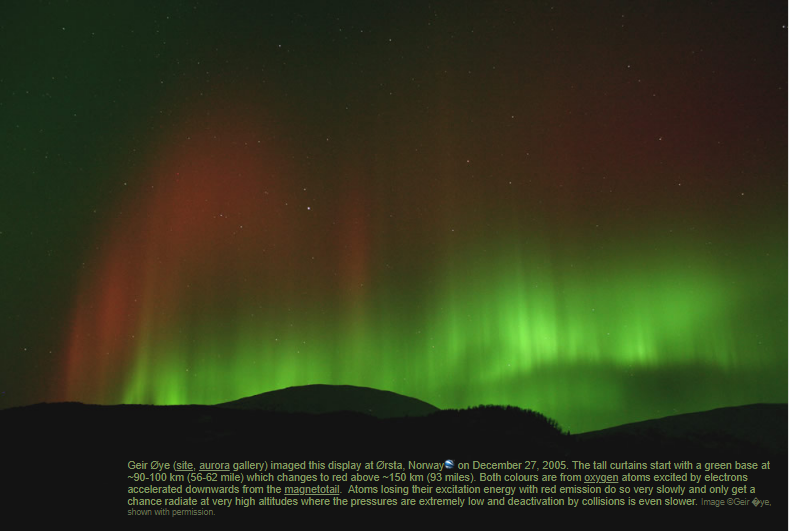Aurora - Ørsta, Norway
Aurora - Ørsta, Norway: A Spectacular Display of Nature's Light Show
The small town of Ørsta, Norway, located in the heart of the stunning Scandinavian landscape, is known for its breathtaking natural beauty. Among its many wonders, one of the most awe-inspiring phenomena to grace the skies above Ørsta is the mesmerizing display of the Aurora Borealis, also known as the Northern Lights. These ethereal curtains of light, dancing across the night sky, leave spectators in a state of wonder and awe. Geir Øye, a talented photographer, captured a particularly captivating image of this celestial spectacle on December 27, 2005, showcasing the magic that unfolded above Ørsta on that memorable night.
The captivating image captured by Geir Øye provides a glimpse into the enchanting world of atmospheric optics. The tall curtains of light, gracefully stretching across the sky, start with a vibrant green hue at an altitude of approximately 90-100 kilometers (56-62 miles). As our gaze ascends higher, we witness a fascinating transformation as the color shifts to a mesmerizing red above 150 kilometers (93 miles). This remarkable color change is a result of oxygen atoms in the Earth's upper atmosphere being excited by electrons accelerated downwards from the magnetotail.
At these extreme altitudes, where atmospheric pressures are incredibly low, the deactivation of these excited oxygen atoms occurs at an exceptionally slow pace. Consequently, the atoms emitting red light have the opportunity to radiate their energy over vast distances. This phenomenon explains why the red emission is visible only at such great heights, creating a breathtaking spectacle that seems almost otherworldly.
The Northern Lights owe their existence to the complex interplay between our planet and the Sun. As charged particles from the Sun's solar wind interact with Earth's magnetosphere, they create a dynamic dance of energy and light in the upper atmosphere. The colors observed in the Aurora are determined by the type of gas particles present and their altitude.
In the case of the Ørsta Aurora, the green color is a result of oxygen atoms at lower altitudes, between 90-100 kilometers (56-62 miles). These atoms become excited and emit green light when they collide with the solar wind particles. As the energy from the electrons accelerates downwards from the magnetotail, it imparts this energy to the oxygen atoms, causing them to emit their characteristic green glow.
However, as we ascend higher into the atmosphere, beyond 150 kilometers (93 miles), a different phenomenon takes place. At these extreme altitudes, the oxygen atoms excited by the electrons undergo a slower deactivation process due to the extremely low atmospheric pressure. Consequently, the red emission becomes visible as the atoms radiate their energy over vast distances, creating a captivating display that adds an extra layer of wonder to the already enchanting Northern Lights.
Witnessing such a magnificent display of nature's light show is an experience that words can hardly do justice. The vibrant colors, gracefully moving across the night sky, leave spectators in a state of awe and wonder. The photograph captured by Geir Øye is a testament to the beauty and grandeur of the Aurora Borealis, reminding us of the mysteries that lie beyond our everyday perception.
The town of Ørsta, with its serene natural surroundings, provides an ideal setting for observing this celestial phenomenon. Away from the bright lights of bustling cities, Ørsta offers a peaceful sanctuary where one can truly immerse themselves in the magic of the Northern Lights. Whether you are a seasoned astrophotographer or simply an admirer of nature's wonders, Ørsta is a destination that promises an unforgettable experience.
As we gaze upon Geir Øye's photograph of the Ørsta Aurora, we are reminded of the sheer beauty and intricacy of our universe. The dance of light and energy taking place in the upper atmosphere is a testament to the wonders that await us if we dare to look up and embrace the mysteries that lie beyond our world. So, let us venture into the night, to Ørsta, Norway, and witness firsthand the captivating spectacle of the Aurora Borealis.

Geir Øye (site, aurora gallery) imaged this display at Ørsta, Norway on December 27, 2005. The tall curtains start with a green base at ~90-100 km (56-62 mile) which changes to red above ~150 km (93 miles). Both colours are from oxygen atoms excited by electrons accelerated downwards from the magnetotail. Atoms losing their excitation energy with red emission do so very slowly and only get a chance radiate at very high altitudes where the pressures are extremely low and deactivation by collisions is even slower. Image ©Geir �ye, shown with permission.
Note: this article has been automatically converted from the old site and may not appear as intended. You can find the original article here.
Reference Atmospheric Optics
If you use any of the definitions, information, or data presented on Atmospheric Optics, please copy the link or reference below to properly credit us as the reference source. Thank you!
-
<a href="https://atoptics.co.uk/blog/aurora-rsta-norway/">Aurora - Ørsta, Norway</a>
-
"Aurora - Ørsta, Norway". Atmospheric Optics. Accessed on November 26, 2024. https://atoptics.co.uk/blog/aurora-rsta-norway/.
-
"Aurora - Ørsta, Norway". Atmospheric Optics, https://atoptics.co.uk/blog/aurora-rsta-norway/. Accessed 26 November, 2024
-
Aurora - Ørsta, Norway. Atmospheric Optics. Retrieved from https://atoptics.co.uk/blog/aurora-rsta-norway/.